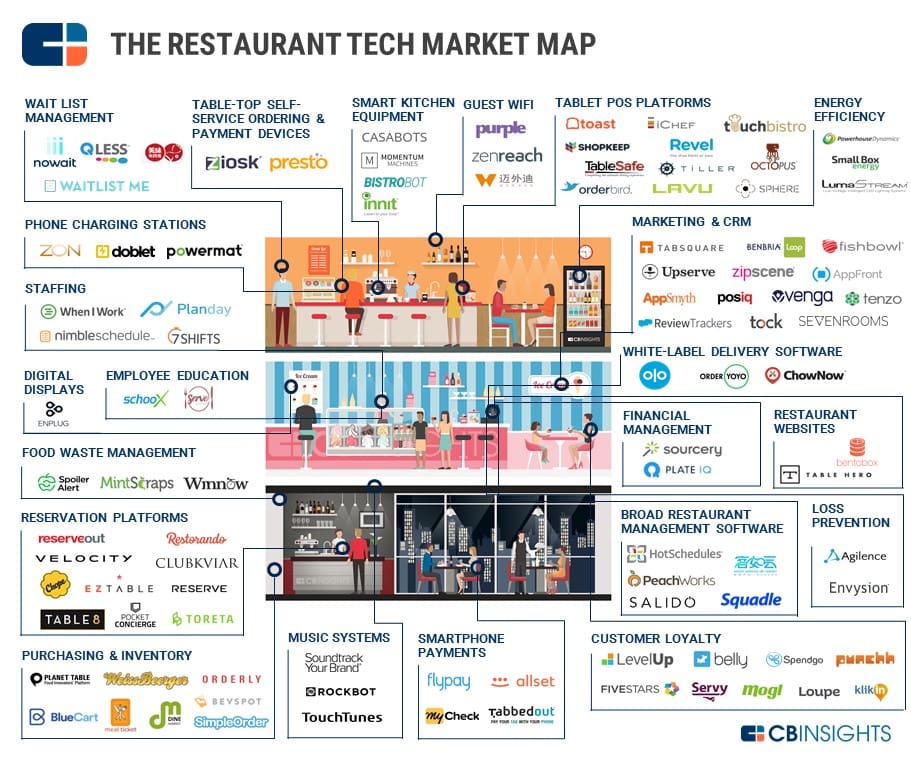I have been writing blogs about what liberal arts institutions have failed to do in the new 21st century environment. My focus has been trying to find direct links between job placement, earnings and lifetime learning skills. Unfortunately, there aren’t a lot of those!
Should there be? Perhaps…but let’s discuss the indirect links. And if you believe in indirect links, shouldn’t liberal arts institutions be thinking about this linkage themselves, both formally and informally? Let me give you an example. While I am not always a current reader, I came across the August edition of CB Insights and was particularly struck by the article entitled, “The Future of Dining: 99 Startups Reinventing The Restaurant In One Infographic.”
What is interesting about this article is that it is all about the Internet of Things…which is alive and well and growing. For example, in the restaurant business, some restaurants “are nearly fully automated and require minimal, if any, interaction between employees and customers.” So, what has this got to do with colleges?
Well, if your higher ed institution is not thinking about this, it should be. And if it is thinking about it, it should be doing something because the IofT will be affecting every college and university’s student population shortly.
The future is coming. Or more accurately, it is already here.
To see what I mean, check out the infographic below from the CB Insights article.

As you can see, robots and technology are going to replace a significant amount of the workforce. What does this mean for higher ed? Specifically, that how they are preparing students for the future is about to be completely dismantled as a large number of folks either entering the workforce or currently in the workforce are going to be displaced.
This is both pretty exciting and pretty scary. What are colleges doing about it? I’m not sure if they are doing anything but they had better start thinking about doing something now!
What action is required? A two-part dilemma.
The first part of a possible solution is: Do I (as an institution of higher learning) have a strategy that is consistent with preparing college graduates for the future? Not sure. This is such a radical step for a liberal arts institution that it really means throwing away what you have done for the last hundred years and making a very quick pivot. Can a college administration pull this off and bring the trustees and all other parties along?
The second part of this is resourcing. Preparing for the future might reveal that you are not adequately equipped to meet the new needs. And then what do you do? In either case, you are going to have to make a seismic shift to survive and thrive in the new world.
So where does this leave us?
Let me say that I am a great believer in a classical liberal arts education. I think that critical learning skills are important. I also bemoan the fact that people don’t know history, don’t read the newspaper and don’t attend classical concerts. But I also recognize that having that knowledge base is only important if you also have the technical skills required to compete in the 21st century.
This is really about balance, isn’t it? About re-juggling resources. About being receptive to what is going on in the real world as well as in the college marketplace and then offering students hands-on programs that make them more productive, more job-ready and more able to compete.
Furthermore, what I also think this means is that we need to go back to STEM programs, something that students thought they escaped when graduating from high school. Given today’s increasingly digital world, shouldn’t these basics be added as requirements in college? Because these skills are necessary to survive in today’s environment.
Bottom line: Colleges need to better prepare students for high-potential entry level jobs.
Did you know that currently there are 1 million jobs that cannot be filled because students don’t have the necessary skills? This doesn’t speak well for us as an economy or as a society. And, if your college is not providing those skills that are needed in today’s job market, I suspect that the ROI on your college investment isn’t so good.
And yet this happens (or depending how you feel, doesn’t happen) every day. What to do about it? Start asking the right questions, such as: Who in your college is teaching creativity? And by creativity, I don’t mean creative writing but creative thinking. For example, I refer back to some of the new technologies mentioned in the CB Insights article: wait-list management, table-top self-service ordering and payment devices, smartphone payment platforms, phone-charging stations, customer loyalty analytics, employee scheduling software, data-driven marketing and cloud-based HVAC control systems to reduce energy and maintenance costs.
One more thing: Who is teaching the what ifs?
Who is encouraging kids to think out of the box? In the old days (when I went to college or even when my daughters did), a liberal arts education’s purpose was to stimulate creativity. Yet, the world has changed enormously since then. Are we doing enough to stimulate creativity in this new environment? Unfortunately, I’d have to say no. But, that means there is the opportunity to do better! And not a moment too soon.
Check out our additional blogs on higher ed
At Simon Associates Management Consultants, we have written several blogs on the state of higher ed today and how it should be doing more to better prepare its students for well-paying jobs. Check them out by clicking on the red bar below. And let us know your thoughts and insights in this area by going to the Contact Us page on our website.

Andy Simon, Partner
Simon Associates Management Consultants




